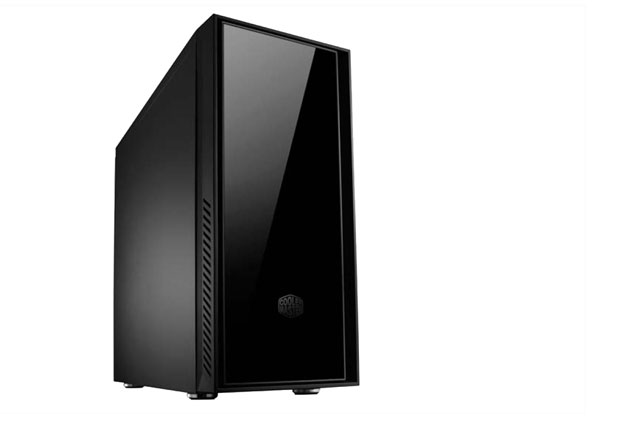Sub £1,000 workstations used to mean a major trade off in most areas – CPU, memory, hard drive, and graphics. But as Scan’s latest entry-level machine demonstrates the sacrifices don’t have to be nearly as big as they used to be.

Scan-3XS-GW-MT15
Scan’s 3XS GW-MT15 is focused squarely on entry-level 3D CAD, but this doesn’t mean you have to give up raw CPU performance. Overclocked to 4.4GHz the quad core Intel Core i5 3570K processor packs a huge punch for CAD, where clock speed is king.
This ‘Ivy Bridge’ chip is a cool £70 cheaper than the popular Core i7 3770K and there should be very little noticeable difference in day-to-day modelling operations.
The main distinction between the two is the Intel Core i5 3570K doesn’t support Intel HyperThreading, which should give a welcome 15% boost in most ray trace renderers. So, unless rendering is an important part of your workflow, consider it money well saved.
Most entry-level workstations ship with 8GB of RAM, but Scan has managed to pack in an impressive 16GB into this machine, populating two of the four DIMM slots with 8GB DDR3-1600 modules. For those that work with small assemblies much of this will probably go unused, so it could be worth scaling down to 8GB if budget is tight.
Fresh from the manufacturing plant Scan has included Nvidia’s brand new Quadro K600 graphics card. We look at this 1GB Kepler board in some detail here – the conclusion being that it’s ideal for entry-level CAD, but starts to show its limitations when advanced real time shading effects like SolidWorks RealView are turned on.
When working with large assemblies, should you want to bring your model to life, we’d recommend effects are toggled off to keep model rotation smooth.

Once the side panel is off, the CoolerMaster Silencio RC-550 provides easy access to the hard drives
In terms of storage, Scan has opted for a dual drive setup: a 120GB PNY XLR8 Solid State Drive (SSD) for OS and applications and sizeable 2TB Seagate Barracuda SATA drive for data. Considering the price of the machine this is pretty impressive, though I’d personally allocate a bit more budget to the SSD. For an additional £26 you can upgrade to a professional PNY 120GB Prevail Elite which is not only rated by PNY as being 10x higher in terms of its long term endurance, but our tests confirm that it is significantly faster than the consumer-focused PNY XLR8. £26 well spent I’d say.
For what is essentially a budget workstation it’s good to see Scan has still managed to present it in a quality chassis. The CoolerMaster Silencio RC-550 is solid in construction, provides easy access to the hard drives inside and also includes some handy top mounted USB ports.
With a substantial CPU heat sink and insulated with acoustic foam, the machine is also incredibly quiet in operation. However, in fairness, with the CPU rated at 77W and the GPU at 41W there’s not a huge amount of heat being generated inside so the fans shouldn’t be taxed too much anyway.
Overall, the Scan 3XS GW-MT15 is an impressive entry-level machine, which, thanks to its overclocked CPU, can mix it with the best when it comes to raw CAD performance.
The only real limitation as far as CAD is concerned is with graphics where large assemblies, particularly those presented with advanced real time shading, could become a little sluggish on screen.
Other than that, even with a few tweaks here and there, perhaps to upgrade the SSD, it’s possible to keep it under that all-important £1,000 threshold. Impressive stuff from Scan.
To view comparative scores from other workstations please click here
For details of all our specific CAD/CAM/CAE benchmarks click here
Specifications
Quad Core Intel Core i5 3570K Ivy Bridge CPU (3.4GHz overclocked to 4.4GHz)
16GB (2 x 8GB) Corsair PC3-12800 (1600) RAM
Nvidia Quadro K600 (1GB DDR3) graphics
120GB PNY XLR8 Series SSD
2TB 7,200RPM Seagate Barracuda 6Gb/s SATA drive
Gigabyte GA-Z77-D3H motherboard.
Microsoft Windows 7 Professional 64-bit
3 year – 1st year onsite, 2nd and 3rd year return to base (parts and labour)
CPU benchmarks
(secs – smaller is better)
CAM (Delcam PowerMill 2010) – 1) 140 2) 245 3) 357
CAE (SolidWorks 2010 Simulation) – 79
Rendering (3ds Max Design 2011) – 253
Graphics benchmarks
(bigger is better)
CAD (SolidWorks 2013) – 30
CAD (Creo 2.0 – SPECapc graphics test) – 2.85






